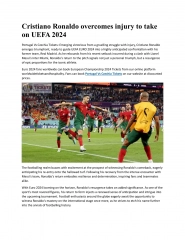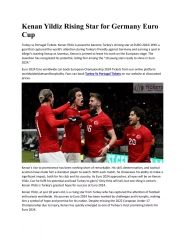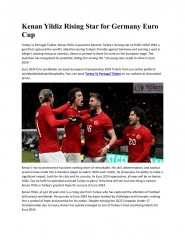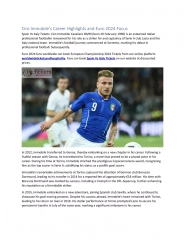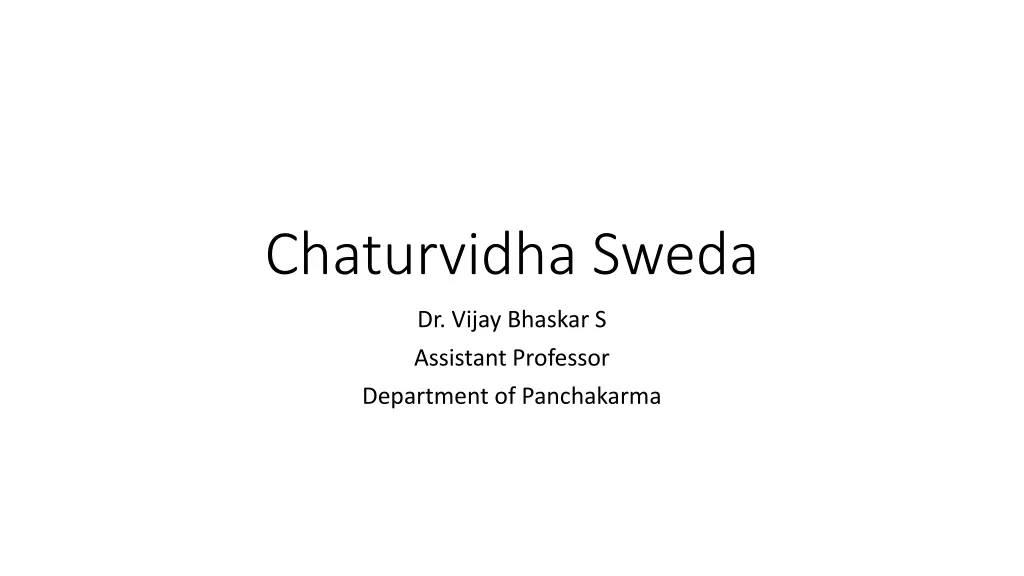
Chaturvidha Sweda: Understanding the 4 Types of Classification as per Ayurveda
Explore the 4 types of Sweda (sweating therapy) as classified by Vagbhata and Susrutha in Ayurveda, including Tapa Sweda, Ushma Sweda, Upanaha Sweda, and Drava Sweda. Learn about the methods, materials, and dosha-based actions of each Sweda type. Enhance your knowledge of Ayurvedic therapies for holistic well-being.
Uploaded on | 13 Views
Download Presentation

Please find below an Image/Link to download the presentation.
The content on the website is provided AS IS for your information and personal use only. It may not be sold, licensed, or shared on other websites without obtaining consent from the author. If you encounter any issues during the download, it is possible that the publisher has removed the file from their server.
You are allowed to download the files provided on this website for personal or commercial use, subject to the condition that they are used lawfully. All files are the property of their respective owners.
The content on the website is provided AS IS for your information and personal use only. It may not be sold, licensed, or shared on other websites without obtaining consent from the author.
E N D
Presentation Transcript
Chaturvidha Sweda Dr. Vijay Bhaskar S Assistant Professor Department of Panchakarma
Objectives To understand the 4 types classification of sweda told by Vagbhata and Susrutha Detailed Knowledge and the procedure of individual swedas Dosha Based Action of chaturvidha sweda
Introduction ; - , , , ; Types: 1. Tapa sweda 2. Ushma sweda 3. Upanaha sweda 4. Drava sweda
Tapa Sweda , || Method to induce tapa sweda are Pani : Hand Kamsya: Bronze Kanduka: Metal made balls Kapala: a fragment or piece (karpara) heated by flames Valuka: sand Vastra: Clothes Khadira angara
Ushma Sweda Definition , | (Susrutha chikitsa sthana) Materials used to induce Ushma Sweda Kanduka, pashana, ishtika, loha pinda Procedure Red hot materials are put into amla Dravya to produce steam and the body part to be exposed to this steam after covering the area with a moist cloth.
Upanaha sweda | Kakolyadi in pittanubanda vata Eladi, surasadi in kaphanugata vata Tila, Atasi krishara veshavara salvana in kevala vata
Salvana Upanaha The Upan ha rich in salt is called S lva aUpan ha. In this the K koly di Ga a Dravya, V t h ra Dravya, Amla Dravya, n pam sa, Sneha, Lava a in excess quantity are made into a paste and bandaging is done with silk cloth. Indicated in Atyanta ruja , G trasa koca , G tra stabdha
Drava sweda , ; || Dravadravaya like Vatahara kwatha Payas, mamsarasa, yusha, taila, dhanyamla, ghritha, vasa, mutra
Action based on Dosha pradhanyatha , , || Tapa sweda and ushma sweda Sleshmaghna Upanaha sweda Vataghna Drava Sweda- pittaghna
Knowledge about 13 types of Sagni Sweda
Sagni Sweda 13 fold classification | || || | (Cha. Su. 14/39)
1 1. Sankara . Sankara Sweda Sweda Definition ||(Cha. Su. 14/41) The process of thermal sudation by means of a bolus with or without wrapping cloth is known as San kara Sveda or Pi da Sveda. Sub Classified into Two types: Ruksha and Snigdha
Dravya used for SNIGDHA SNIGDHA and RUKSHA RUKSHA Sweda Snigdha Pinda Sweda dravyas | || Rooksha Pinda Sweda dravyas | || || |
2 2. . Prastara Prastara Sweda Sweda || Type: Snigdha Platform prepared by spreading u ka or ami Dha nya, Pula ka, Ve ava ra (steamed boneless meat), Pa yasa (sweet porridge), Kr ara (boiled mixture of pulses and cereals), and Utka rika (pudding cake) evenly and cover it with Kau eya Vastra, Eran d a Pa tra or Arka Patra. Then the patient who has properly anointed with oil should lie over this and cover the body with blanket till proper Svedana occurs. Indicated on prshtasula, parsva shula, kati shula, Kati graha
3 3. Nadi . Nadi Sweda Sweda Procedure Varu a, Gud ci, igru, M lati , Br hat Pa cam la etc or animal-based articles (flesh and heads of animals and birds Sour, salt or unctuous substances and urine, milk, etc. Pitcher with a pipe made up of leaves of Va a, Kara ja or Arka with its fore part having the shape of the trunk of an elephant is inserted.
Measurements of Nadi sweda Yantra Length of pipe: 1 vyama (91.44cm) or half a Vy ma (45.72 cm) Circumference of proximal end: one-fourth of a Vy ma (22.86 cm) Circumference of distal end: one-eighth of a Vy ma (11.43 cm) Shape of the tube: Curved twice or thrice Logical reasoning for the curved shape is: Curvatures of the pipe help in lessening the intensity of steam and thus help in providing a comfortable fomentation experience.
4 4. . Pariseka Pariseka sweda sweda || Materials Used: M l di (Patra, Phala) which alleviates V ta , V ta Kapha Decoction prepared with Patra Bhan ga (chopped leaves) of igru, V ra aka , Era d a, Kara ja, Surasa, rjaka, iri s a, V s , Va a, Arka, M lati , Di rgha Vr nta, Vac di, n pa v rija M sa and Da am la added with Ghr ta , Sur , ukta, V ri or Ks i ra
Procedure Instruments used: Kumbhi, Vars a ika, Pran d i Method Decoction of the prescribed drugs is prepared and Luke warm decoction is filled into Kumbhi, Vars a ika or Pran d i. Then Paris eka can be performed after Abhyan ga Cover the body with cloth during the procedure Indications: Pitta sa sr s t a conditions, Sandhigata V ta, Paks gh ta, V tarakta, Skin diseases




